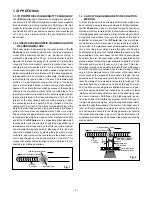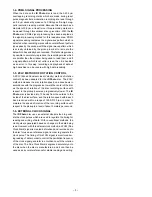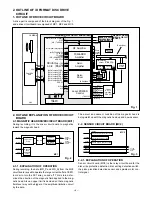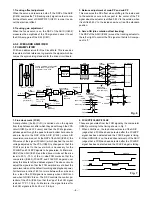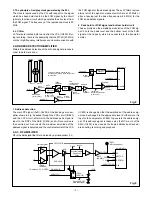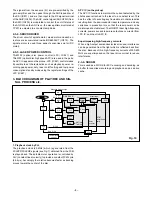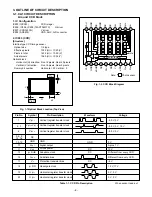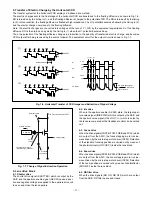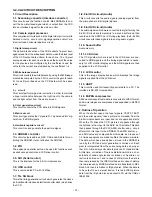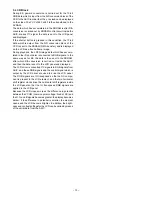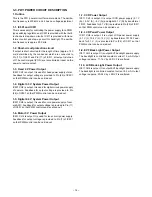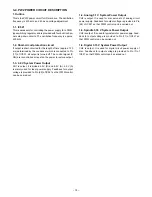
– 2 –
1.
iD PHOTO
DISC
1-1.
iD PHOTO
DISC HIGH-DENSITY TECHNOLOGY
The iD Photo Disc has a diameter of 5 centimeters and yet it
can store up to 730MB of information. A laser pulse magnetic
field modulation recording method and CAD-type ultra-high
magnetic resolution method have been used to record data
at a track pitch of 0.6
µ
m and an extremely short mark length
of 0.235
µ
, which is smaller than the spot diameter of the
laser beam.
1-2. LASER PULSE MAGNETIC FIELD MODULATION
RECORDING METHOD
The beam which is generated by the laser pickup in the iD
Photo disc drive focuses onto the disc recording medium as
a spot with a diameter of about 1
µ
m. During recording, a
mark with a diameter of 0.235
µ
m -- which is smaller than the
diameter of the laser beam spot-- is recorded. A “laser pulse
magnetic field modulation” recording method has been
adopted in order to achieve this. This recording method in-
volves firstly a magnetic head which applies a magnetic field
which is modulated in accordance with the data supplied ex-
ternally which is to be recorded. In this state, the laser beam
is directed to the reverse side of the disc. The radiated light
within an 0.6
µ
m-diameter area at the center of the beam
spot is momentarily heated to a temperature of around 200
degrees. The data is then recorded by means of the resulting
change in the magnetic polarity of the recording layer. The
recording mark which is made by this pulse-type laser beam
is accurately formed in the track at a diameter of 0.6
µ
m. The
rotation of the disc causes each recording mark to overlap
the preceding mark at a point 0.235
µ
m forward of the pre-
ceding mark. As a result, the circles formed according to the
state of the laser beam move along and leaves a continuous
series of minute crescent-shaped marks 0.235
µ
m across.
These marks are approximately one-quarter the size of the
recording marks which are made on other media such as CDs
and MOs. The iD Photo disc is a magneto-optical disc which
records data uses the principle of applying magnetism and
temperature sumultaneously so that the recording medium
can maintain its magnetic polarity. Because of this, the data
cannnot be erased simply by placing the disc within a mag-
netic field, and moreover the recording method does not re-
sult in any changes to the physical nature of the disc. This
means that stable characteristics can be maintained for re-
spected disc writing operations.
1-3. CAD ULTRA-HIGH MAGNETIC RESOLUTION
METHOD
In order to play back the extremely small marks which have
been recorded using laser pulse magnetic field modulation,
the iD Photo disc uses a ultra-high magnetic resolution
method which incorporates CAD (Center Aperture Detection).
Ultra-high magnetic resolution is a form of technology in which
a magnetic signal taken from only the center of the spot is
extracted for playback. The iD Photo disc has a multi-lay-
ered structure which comprises a polycarbonate substrate,
upon which is the playback layer with magnetic characteris-
tics, a recording layer which stores the data, and finally a
heat dispersion layer which rapidly allows the spot which has
been heated by the laser beam to cool. When data is played
back from the disc, the laser beam which is generated by the
pickup passes through the polycarbonate substrate to reach
the playback layer, and focuses on a 1-
µ
m spot. This play-
back layer functions as a screen to shield the recording layer
on which the data is recorded from the laser beam, so that
only a 0.6
µ
m diameter area at the center of the laser beam
which reaches the playback layer passes through it and is
projected onto the magnetic recording area of the recording
layer by means of an increase in temperature (window). The
recorded data can be picked up and read through this “win-
dow”, and the surrounding area is shielded. Moreover, in gen-
eral the spacing between the tracks is narrow and so signal
interference from tracks which are next to the track being read
can occur. However, CAD-type ultra- high magnetic resolu-
tion also solves this interference problem. With CAD-type ul-
tra-high magnetic resolution, only the magnetic signal which
passes throught the window at the center of the beam spot is
read, so that the playback reading area can be restricted to a
very narrow area not only in the tracking direction, but also in
the transverse direction. As a result, signal interference is
suppressed, and the spacing between the tracks can also be
made smaller.
Fig. 1
Fig. 2
recording spot
recording laser beam
disc movement direction
MO pit
0.235µm
ultra-high magnetic
resolution window
playback laser beam
disc movement direction
MO pit
0.235µm
value
temparature
distribution
recording layer
playback layer
T


